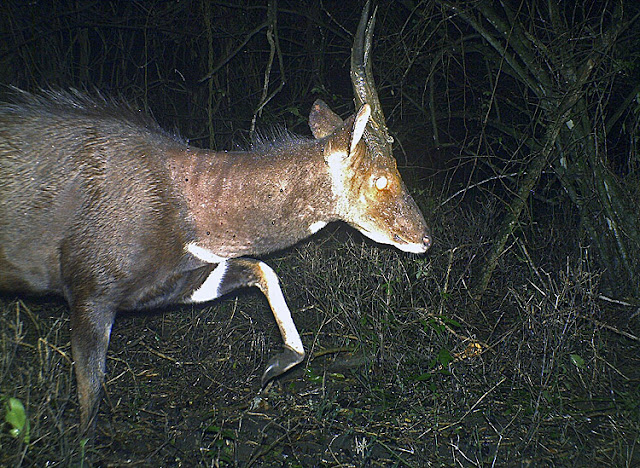 |
| Woody Cape: Home of the Blue Duiker |
One of the species I'm very interested in at Woody Cape is the
Blue Duiker. The Blue Duiker is the world's smallest antelope. Yes, that makes South Africa, and in particular Addo Elephant National Park, home to both the world's largest antelope (the
Eland) and the world's smallest antelope.
Well, technically speaking, there seems to be a lot of competition for the title of "The Smallest Antelope In The World". In my books the Blue Duiker easily shares this title with several other small antelope.
 |
| Blue Duiker (Blouduiker - Cephalophus monticola) at the Woody Cape |
The Blue Duiker has an interesting slit on each side of its face used for scent marking. Both males and females have short horns, although the horns can sometimes be absent from females.
The main diet of the Blue Duiker consists of freshly fallen leaves, flowers and fruit. However being a true
Duiker at heart they also indulge in some carnivorous activities and will supplement their diet with animal material. Sure, a big Common/Grey Duiker can stalk and hunt a mouse/baby bird, but what's available to a hungry little Blue Duiker. Well, apparently they have a sweet tooth for ants, but I'm sure carrion, insects and small vertebrates also form part of their diet.
They are often found near water. I haven't seen any fresh water close to where I've camera trapped these Blue Duiker, so I'm assuming they can manage without free standing water if there is enough moisture in the food and some dew/rain might help as well.
 |
| Sneaking past the camera |
Blue Duiker are often hunted by humans using snares. Despite this they can still be found in many places living very close to human developed areas. This is somewhat surprising to me since the species does not have a particularly fast breeding cycle (about 7 months gestation) nor do they produce many young (usually only one).
To me the adults look very small and vulnerable. One would expect them to be very high on many predators' snack list. But then again I'm yet to photograph any predator that would be a serious threat to an adult Blue Duiker... Maybe the habitat provides enough cover to keep them safe.
 |
| Notice the tiny horns |
The first Blue Duiker image (at the top) was photographed with my trusty old Bushnell Trophy Cam 2009 (without the built in viewer). It has been a great workhorse and I've been very happy with it.
The two images above where taken by my newer Bushnell Trophy Cam XLT (with the built in viewer). My first unit kept on over exposing most of the images. It must have had an electrical from the start because the battery life deteriorated steadily. The unit eventually experienced a full on electrical failure, melting parts of the battery compartment in the process. It was still under warranty so I got it replaces and the new unit is much better. I'm happy with its performance thus far.
I also own one of the new Cuddeback Attack (white flash) camera traps. The image below of a Blue Duiker was taken with this camera.
 |
| The "blue" in their name comes from the blue sheen of their coats, but I think Orange-Legged Duiker might have worked as well |
The Cuddeback Attack is a horrible camera! This might sound a bit harsh, but I love my old Cuddeback Capture and compared to it the new Cuddeback Attack is terrible.
The new Cuddeback Attack is a huge step backwards. The image quality and flash is worse. But the worst of all is the new mounting mechanism. It is absolutely terrible! Anybody who has used an old Cuddeback Capture will know that its mounting mechanism was pretty bad, but Cuddeback somehow succeeded in creating something even worse: the "
Genius Mount System". This new moulting system is truly horrible. In fact I've even lost half of the mounting mechanism somewhere between the Woody Cape sand dunes and the park's offices.
So, now if I want to use the camera I have to be a little bit "creative" when I try to mount it...
 |
| With the Cuddeback "Genius Mount" lost somewhere in the Woody Cape I patented my own system: the "Truly-Genius Mount". Consisting of a helpful tree and a piece of wire it truly surpasses the previous system! |
From the first day the camera didn't impress me. When the recommended firmware update came out I thought "what can I lose" and went ahead with the upgrade.
Um, well...
I followed each step carefully, and according to the output from the camera all went well...
However, I can assure you that everything did not go well.
For example the entire menu is now confused. None of the timer values on the dial (used to set the camera's delay) match with the digital display any more.
But in the end the camera still "works"... So now I use it as is.
In fact this new quirky behaviour even resulted in an unexpected surprise! The camera somehow decided (by itself), halfway through the camera trapping session, to switch itself into video mode. The result of which is a short (and pretty bad) video clip of a Blue Duiker walking past the camera.
Video: A cropped and rotated version of the video taken by the Cuddeback Attack
Camera troubles aside, I think this is a decent start at photographing this intriguing little creature. Now if only I can get one to look at the camera...
















